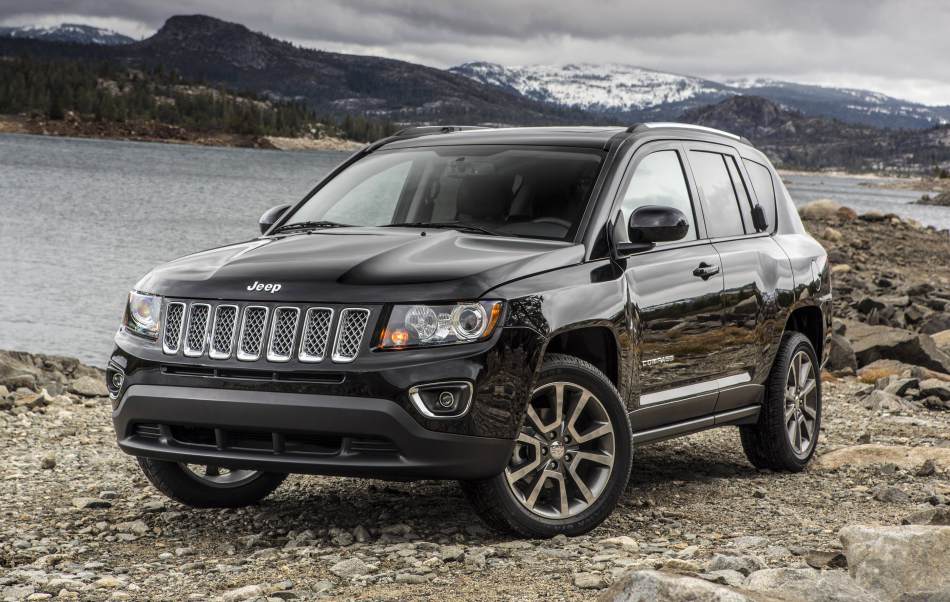The Jeep brand is one of the most iconic in the history of American automobiles. The parent company, Chrysler, has done everything possible to maximize the brand’s value. They have expanded beyond the marquee models Wrangler, Cherokee and Grand Cherokee to offer the Compass and Patriot. These smaller, less-expensive models let budget-minded consumers enjoy the legendary Jeep experience.
We tested a 2014 Jeep Compass Latitude 4×4. With a base price slightly over $24,000, it’s considerably less expensive than the Grand Cherokee. It’s also smaller, less powerful and less luxurious, but the compact SUV size and price are perfect for many young families seeking an all-activity vehicle. It’s also a great choice for empty nesters who occasionally transport grandchildren or people who want a rugged vehicle to tow behind an RV.
Walkaround: The 2014 Jeep Compass Latitude has a strong family resemblance to the Jeep Cherokee and Grand Cherokee. This is very good since those Jeeps are among the most recognizable and desirable SUVs.
Our Latitude model (the middle of Sport, Latitude and Limited models) had handsome 17-inch alloy wheels and P215/65R17 all-terrain tires. The beefy rolling stock boosted the visual appeal. The Jeep Compass has a more macho look than most mini Utes.
Interior: The interior is roomy up front and snug for knees in the back seat. Headroom is excellent throughout. The backseat is rather firm and not our first choice for long trips.
The driver and front passenger seats are fine. The interior materials and fit/finish are reasonable for a vehicle at this price point. The Jeep Grand Cherokee is far, far nicer, but all that luxury comes at a cost. You could easily buy two Compasses for the price of a well-equipped Grand Cherokee (three Compasses if you choose a Grand Cherokee SRT).
A fun feature for people who enjoy tailgate parties is the big liftgate speakers. They can send a lot of music out the back hatch.
Cargo space is simply adequate with the rear seat up, but when the 60/40-split seat is folded the space is very useable. The seats fold almost flat. The rear hatch opening is large for easy maneuvering. The inner wheelwells are covered in cheap plastic.
Small-items storage suffers in the Compass. The door bins, center console, and glovebox are all undersized.
Under The Hood: The Jeep Compass may share some of the Cherokee and Grand Cherokee’s looks, but under the hood choices are more limited. The Compass is only available with two four-cylinder engines. The base engine is the 2.0-liter I-4 that produces 158 horsepower and 141 lb-ft of torque. The greatly preferred optional engine that was in our tester is the 2.4-liter I-4 that ups the output to 172 horsepower and 165 lb-ft of torque.
The Compass is available in either front-wheel drive or all-wheel drive. We think AWD should be standard if for no other reason than this is a Jeep. To our way of thinking a front-wheel drive Jeep is as incongruous as a four-cylinder Viper. Our Compass Latitude 4×4 model had to optional Freedom Drive II Off-Road Group, which beefed up the Jeep factor with items such as Brake Lock Differential, Hill Descent Control, engine and transmission skid plates, fuel tank skid plate shield, tow hooks, engine oil cooler, larger all-terrain tires, heavy-duty floor mats, and the all important “Trail Rated” badge.
There are three available transmissions for the Compass: a 5-speed manual, a 6-speed automatic, and a CVT. We prefer the 6-speed automatic, but our tester had the CVT. It was equipped with an off-road crawl ratio and we didn’t have any real complaints about its performance. Our reluctance about the CVT was mostly in our head. Based on past experiences and the longstanding Jeep image, it just seems like Jeeps should have sturdy, low-ratio manual transmissions or heavy-duty automatics. The idea of a CVT just doesn’t fit our perceptions of Jeeps.
The engine and transmission package worked fine for daily driving. We averaged 21 miles per gallon against the EPA estimate of 20 mpg city and 23 mpg highway. Those estimates are on the low side of competitive compact SUVs.
Behind The Wheel: Driver accommodations are very good and the highway ride is pleasant. The smaller size of the Compass makes it a good city errand vehicle. The engine and transmission get the job done, but lack the reserve power of the Grand Cherokee.
Handling and braking are all good and it doesn’t feel top-heavy.
We’ve driven the Compass on relatively rugged, muddy trails and it performed very well. Its approach and departure angles are excellent and ground clearance is adequate. The optional skid plates are great confidence boosters.
Whines: There is a permanently mounted cup holder on the back seat driveline hump. That makes it awkward for a middle passenger. The rear seat is tight on shoulder space for three adults anyway. The door bins are too small for such an active-lifestyle vehicle.
Bottom Line: The 2014 Jeep Compass is a compromise compared with better known Jeeps such as the Grand Cherokee and Wrangler, but this is a good thing for many buyers. The Compass is Jeep a la carte — you get a solid base without paying for expensive frills.











